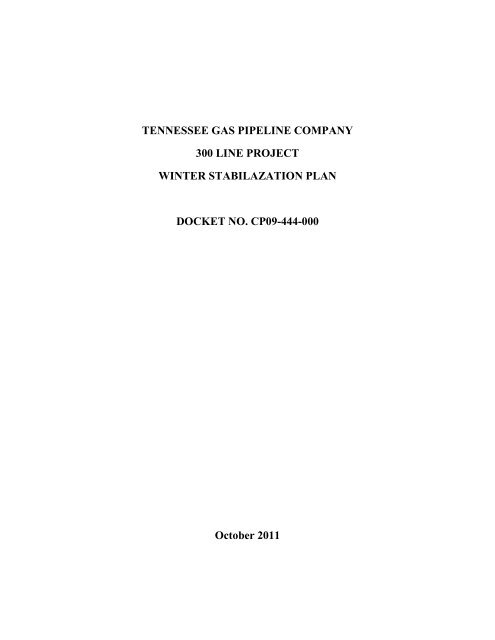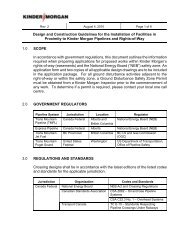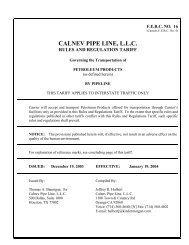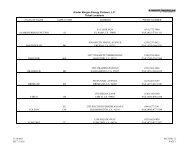Winterization Plan - Kinder Morgan
Winterization Plan - Kinder Morgan
Winterization Plan - Kinder Morgan
You also want an ePaper? Increase the reach of your titles
YUMPU automatically turns print PDFs into web optimized ePapers that Google loves.
TENNESSEE GAS PIPELINE COMPANY300 LINE PROJECTWINTER STABILAZATION PLANDOCKET NO. CP09-444-000October 2011
TABLE OF CONTENTSTENNESSEE GAS PIPELINE COMPANY300 LINE PROJECTWINTER STABILAZATION PLAN1.0 OVERVIEW ..................................................................................................................................... 12.0 ENVIRONMENTAL MANAGEMENT .......................................................................................... 23.0 LANDOWNER COMMUNICATION ............................................................................................. 24.0 SITE GRADING WORK PROCEDURES ....................................................................................... 25.0 TEMPORARY AND PERMANENT EROSION CONTROL PROCEDURES .............................. 36.0 POST-CONSTRUCTION WINTER MONITORING ..................................................................... 47.0 FINAL CLEANUP, RESTORATION, AND REVEGETATION.................................................... 5
2.0 ENVIRONMENTAL MANAGEMENTTennessee is committed to executing this <strong>Plan</strong> and performing the construction of the entire Project to ensure (i)environmental protection and the safety of workers and the public, and (ii) compliance with all conditions of theCommission certificate order and other permits and clearances. Tennessee will reinforce these commitmentsthrough implementation of inspection and reporting procedures as summarized below.At least one EI will be assigned to each Construction Spread of the Project (1 through 4) to monitor the ROW forerosion, the continued effectiveness of erosion and sediment control measures, and compliance with other permitconditions and plans. The EI will be fully supported by Tennessee management. Additional personnel will beidentified and the contact information provided in Table 1 as necessary. The EI will coordinate with the agencies, asnecessary, regarding spring cleanup and/or restoration activities.Table 1Winter Contact InformationName Role LocationContactNumberJamie Ledbetter Construction Manager Dickson City, PA 713.829.3149Mark Hamarich Project Manager Houston, TX 713.819.7033Stephen WeemsProject Manager – Land,Environment, and OutreachBirmingham, AL 205.937.5674Sam Lamendola Chief Environmental Inspector Honesdale, PA 570.994.2630Jason Blackwell Environmental Inspector Towanda, PA- Spread 1 828.989.5546Joe Kienzle Environmental Inspector Honesdale, PA-Spread 2 715.816.4313Rob Robertson Environmental Inspector West Milford, NJ- Spread 3 601.940.4536Rick Crippen Environmental Inspector Coudersport, PA- Spread 4 607.368.2152Rob Wooten Property Rights Spreads 1 - 4 281.782.79113.0 LANDOWNER COMMUNICATIONIn areas in which final restoration has not been completed (area that have been Winterized) and areas with specificlandowner arrangements, Tennessee will begin to contact and notify affected landowners immediately regarding theconditions and proposed action of this <strong>Plan</strong>. The landowners will be provided:• A copy of the “<strong>Winterization</strong> <strong>Plan</strong>” (once approved).• An explanation of why the <strong>Winterization</strong> <strong>Plan</strong> is being implemented.• A description of the temporary stabilization measures to be implemented and that winter stabilizationmeasures will not interfere with their day-to-day activities/travel on their property.• Company personnel (including phone numbers) to contact with questions or problems.• When restoration activities will most likely resume.Tennessee’s Land Agents will coordinate with affected landowners, as necessary, regarding spring cleanupand/restoration activities. A summary Table of landowner concerns will be included in the weekly reports submittedto the Commission.4.0 SNOW MANAGEMENTAlthough not anticipated to be needed, the following will be implemented after significant snow events are followedby an extended period of freeze. If a snow event is followed immediately by a period of melting, normal projectprocedures for handling soil or erosion control will still be in effect.2
If used, snow removal equipment will remain in the approved construction work area. Snow would typically begraded off the access roads with a motorgrader, snowplow, or dozer. Snow will not be plowed down to the roadbed to minimize mixing soils with snow. Equipment tracks may not leave the approved work area. Gaps in thewindrowed snow will be left at drainage crossings and as requested by the landowner. Snow will be removedfrom topsoil or spoil storage areas prior to using.5.0 SITE GRADING WORK PROCEDURESThe following procedures will be implemented during earthmoving activities:• In areas where the EI team determines that soil conditions are favorable, the contractor will continue withfinal cleanup and/or restoration activities.• In areas where the EI team determines that soil conditions are unfavorable for achieving final grade contours,final grading will be limited. At a minimum, grading and environmental crews will provide positivedrainage across the ROW and implement effective long-term soil stabilization measures (such as erosioncontrol devices, mulch, and temporary seeding).• Where topsoil or spoil stockpiles remain in place during the winter, openings in the topsoil or spoil pile atdrainage crossings will be present to allow runoff and snowmelt to be diverted off the work area andminimize interference with runoff.• There will be no open trench, bell-holes, or similar left over winter.• Tennessee will remove all filter bags and dewatering structure components located off-ROW prior to freezeupor snow covering them.• Since topsoil replacement and/or revegetation activities are not scheduled to occur during frozen topsoilconditions, normal temporary stabilization procedures will be applied as ground conditions permit. Thework area will be left in a significantly roughened condition to reduce potential for erosion duringsnowmelt until final cleanup and restoration efforts are completed.• Tennessee will work with landowners to accommodate necessary use of their property or travel on the ROWthat may be affected by snow drifts directly related to the implementation of the <strong>Winterization</strong> <strong>Plan</strong> such asspoil/topsoil piles that have been left.6.0 TEMPORARY AND PERMANENT EROSION CONTROLPROCEDURESThe following temporary and permanent erosion control and stabilization procedures will be implemented inaccordance with the approved Project ECPs. Additional Best Management Practices may be required due to specificsite conditions and will be installed at the discretion of the EIs. Tennessee will closely monitor erosion controlstructures and stabilization efforts during snow-melt periods. Tennessee is committed to ensure that all erosioncontrols are operational for the duration of winter and to withstand spring thaw and snowmelt periods.• All erosion control devices (such as slope breakers, sediment traps, straw bales, and silt fences) will berepaired and properly maintained until Project completion. Special measures (including using sand bags,coir logs, and/or compost filter socks) may need to be taken to repair/maintain ECDs during periods offrozen soils.• Final grade and restoration of ROW contours would continue until the ground becomes too wet or frozen tosuccessfully restore grade to the ROW, as determined by the EI team and/or Construction Manager. In theareas where final grade contours are not able to be achieved, the areas will be graded to provide positive3
drainage, and stabilized as best as practicable prior to the commencement of the winter construction perioduntil conditions allow for the final grading to be achieved.• In sections of ROW where topsoil segregation was completed, the topsoil piles would be left in theirstabilized condition and replaced in the spring when the weather conditions permit the properdecompaction of the areas. The exposed subsoil would be seeded with a winter seed and mulched tominimize erosion-related problems. The mulch should be in good condition and care taken to avoidutilizing any mulch containing noxious weed seed.• In all Project areas, as the condition of the ROW permits, all temporary and/or permanent slope breakerswould be installed consistent with the approved erosion control plans and Commission and other agencyrequirements, and in any other locations where the EI staff and/or Tennessee believes that slope breakerswould be necessary. The contractor would be responsible for ensuring the slope breakers are of sufficientsize and outflow angle to successfully transport run-off into sediment traps (temporary slope breakers) off-ROW, or into straw bale or silt fence “J-Hooks” located at the ends of the breakers.• All areas will be seeded with 50 pounds per acre of an annual winter seed. At the contractor’s discretion,application of the final seed mix (in addition to the annual seed) would continue, provided that in the eventthe final seed mix does not germinate in the spring, over seeding of these areas of insufficient germinationwill be completed.• All disturbed Project areas will be mulched at a rate of 3 tons per acre. .• Timber mats may be left in the wetlands to allow for travel during final restoration activities. Mats will beremoved from areas prone to flooding so they do not float off-ROW during spring flooding.• The contractor will remove equipment bridges and if necessary, leave enough bridge mats at each location toallow for the installation of an equipment bridge adequate to allow crossing of equipment and vehicletraffic needed for final cleanup and restoration. Stream banks will be restored and stabilized in accordancewith the ECPs following the removal of equipment bridges.• The contractor will leave access pads and temporary fence gaps in place. The removal of the access pads andthe installation of permanent fencing will be performed as part of final restoration activities.7.0 POST-CONSTRUCTION WINTER MONITORINGOnce the proposed cleanup, restoration, and <strong>Winterization</strong> activities have been completed for 2011, Tennessee willcontinue to maintain the appropriate erosion and sedimentation controls as needed during the winter period.Tennessee representatives, as identified above, will be available during this time to address erosion issues andlandowner concerns that may arise.During the anticipated winter shutdown, Tennessee will inspect the ROW on a regular basis (minimum of biweekly)and identify where erosion control measures are damaged or are ineffective, and where corrective measuresneed to be taken when conditions allow. The extent of inspections will be based on precipitation events, runoffamounts, and thawing. Where frozen conditions persist for long periods of time, regular inspections may not benecessary. When snow melts or the ground thaws, the potential for erosion increases and the frequency ofinspections would increase.The inspections will pay particular attention to Winterized areas, environmentally sensitive areas such as steepslopes, wetlands and waterbodies, road crossings, and residential areas. These inspections will identify:• Erosion control structures requiring maintenance and/or repair.• Areas of slope instability.• Areas where significant levels of erosion are occurring.• Revegetation success.4
The EI and Construction Manager will determine the most effective means of dealing with identified problems,taking into consideration the suitability of the construction work area for access by equipment, potential damage thatcould occur by equipment accessing the construction work area, and the urgency/significance of the problem.Corrective actions may be deferred until spring where no sensitive resources would be impacted, where access is notfeasible, or where damage from accessing the site would outweigh the benefits of correcting the issue during thewinter.8.0 FINAL CLEANUP, RESTORATION, AND REVEGETATIONFinal cleanup, restoration, and revegetation activities will occur as soon as practicable in 2012 (anticipated to beapproximately mid-April) and will be completed in accordance with the approved Project ECPs. Tennessee willnotify the Commission and the appropriate agencies prior to the initiation of the final cleanup, restoration, andrevegetation activities.5
















